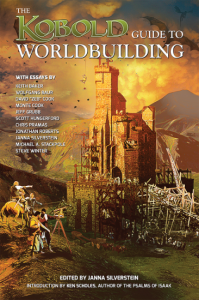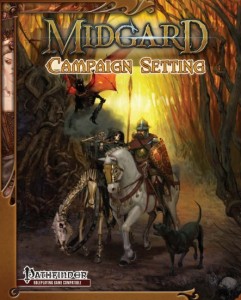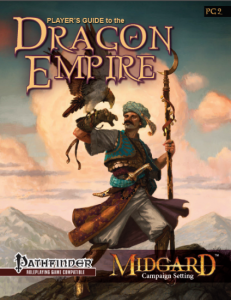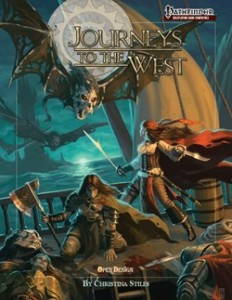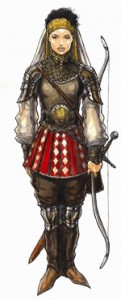Kobold Press, their Midgard Campaign Setting is in my opinion traditional high fantasy, but at the same time a flavorful bag of wondrous ideas. The 13th Age RPG by Rob Heinsoo, Jonathan Tweet and Lee Mojer does a great job including indie RPG concepts (e.g. One Unique Thing) into Dungeons & Dragons. This is what I am looking for – something independent or original.
I played nearly all original incarnations of Dungeons & Dragons and visited a lot of the official worlds, but I always preferred rules-light systems like Tunnels & Trolls or the original Cyberpunk (2013). I criticize the still popular wave of D&D clones like Pathfinder, Dungeon Crawl Classics or Swords & Wizardry. For my tastes they are too close to the original game(s). Nevertheless, I occasionally steal from them for my games.
Game and world design is one of my favorite hobby topics. This is the reason for my first and recommendable Open Design product The KOBOLD Guide to Game Design Vol. 1.
The open and community-driven approach to create adventures and campaigns is also interesting to me, but because of the focus on D&D/Pathfinder I did not support any of them until the Midgard Campaign Setting. This book contains game material for the Pathfinder RPG and the fine Age game engine of the Dragon Age tabletop RPG.
Midgard is not Rokugan (Legend of the Five Rings), the World of Darkness or even Glorantha, but this D&D-styled and somewhat „generic“ world is full of character and great ideas.
Currently I am thinking about a game using the Midgard Campaign Setting and (my personal D&D Next) 13th Age. I like both products alot – they are inspiring.
This is the rationale for my „D&D interviews“. As you can see Wolfgang Baur was kind enough to answer all my questions.
obskures.de: Hi, Wolfgang Baur. Please introduce yourself to our readers, and tell us a bit about your gaming experiences.
![]() Wolfgang Baur: Sure! I’m a lifelong gamer, and very fond of D&D, Pathfinder, Call of Cthulhu, Empire of the Petal Throne, and the Dragon Age RPG, among many others.
Wolfgang Baur: Sure! I’m a lifelong gamer, and very fond of D&D, Pathfinder, Call of Cthulhu, Empire of the Petal Throne, and the Dragon Age RPG, among many others.
I’m also a game designer, editor, and publisher for tabletop RPGs. I started with writing for Dungeon Magazine, then editing Dragon Magazine, then back to design on D&D and Alternity for TSR and Wizards of the Coast.
These days I write for my own publishing imprint, Kobold Press, and I also freelance for Paizo Publishing and a few others. Much of my gaming in the last 5 to 10 years has been playtesting.
obskures.de: What was your first roleplaying book?
![]() Wolfgang Baur: The Blue Box for D&D was my introduction to role playing games, though I’d played the Dungeon! board game before that. I guess technically, though, that’s not a book.
Wolfgang Baur: The Blue Box for D&D was my introduction to role playing games, though I’d played the Dungeon! board game before that. I guess technically, though, that’s not a book.
The first roleplaying book I bought with an actual spine on it was probably the AD&D Monster Manual in the late 70s. I look at it now and I still see wonderful bits of nostalgia, and it was my ticket into great worlds of adventure.
If I might plug a product from my good friends at Paizo, I think the Pathfinder Beginner Box would be an excellent first exposure to role playing games for anyone today. It deserves to be given as a gift to every friend or relative who has any interest in fantasy and games.
obskures.de: Kobold Quarterly magazine is dead. Kobold Press is alive and on the way to new horizons. On your website you have an extensive FAQ about your decision. Please tell us briefly, what happened? And what is the difference between Kobold Press and Open Design?
![]() Wolfgang Baur: Kobold Press is an imprint: the name that things are published under. Open Design LLC is the company behind that imprint. It’s a bit like Tor, which is an imprint of Random House. (Well, except that Kobold Press is small enough to fit into a meeting room in Tor’s back office!)
Wolfgang Baur: Kobold Press is an imprint: the name that things are published under. Open Design LLC is the company behind that imprint. It’s a bit like Tor, which is an imprint of Random House. (Well, except that Kobold Press is small enough to fit into a meeting room in Tor’s back office!)
As to what happened with Kobold Quarterly, the magazine grew into a huge commitment of time and energy for me and my wife, Shelly. I always hoped it would become a full-time paying job for one of us, but it never quite got there. While the magazine was widely-read and award-winning – and heavily pirated! — it barely broke even. Like many magazines, it ran largely on love and volunteers. With two small children in the house, my wife and I decided it was time to take our evenings and weekends back for family time, so we folded up shop. It was a tough conversation, and I remember Kobold Quarterly with a great deal of love. I’m going to miss it, but it was the right decision for us.
And I’m quite proud of the 5-year run of Kobold Quarterly. We published an interview with Dave Arneson and many other industry greats, as well as reams of official material for Pathfinder RPG including Pathfinder Society Quests and official Golarion arch-devils. And of course, the many elements of the Midgard Campaign Setting first appeared in the magazine. Kobold Quarterly published articles by Monte Cook, Ed Greenwood, David “Zeb” Cook, Jeff Grubb, and Skip Williams, as well as ferociously talented newcomers like Josh Jarman and Adam Daigle and Rodrigo Garcia Carmona. It was a blast.
I’m happy to see that Gygax Magazine is picking up the torch of RPG magazine, and I have directed some of the KQ authors that way. I look forward to subscribing and supporting it, and I would encourage others to do the same.
obskures.de: The Midgard Campaign Setting is now available, even in Germany. Give us an elevator pitch of your new world, and what is, in your opinion, its unique selling point. What differentiates Midgard from worlds like Pathfinder’s Golarion, Forgotten Realms or the old classic Mystara for Dungeons & Dragons?
![]() Wolfgang Baur: The Midgard Campaign Setting grew out of my own long-running homebrew D&D campaign. In fact, the first inklings of Midgard can be found in campaign notes that I started keeping when I was a teenager. It’s a dark world of deep magic, full of the forests of the Brothers Grimm and the monsters and myths of the medieval mind. The design is a conscious effort to build a plausible, entertaining, and mythologically sound fantasy setting by embracing the genre’s European roots, rather than running away from them. Too many designers seem to think that European fantasy is somehow worn out: I think that shared tradition makes fantasy most exciting, because it undergirds everything from Conan to Lord of the Rings to Game of Thrones.
Wolfgang Baur: The Midgard Campaign Setting grew out of my own long-running homebrew D&D campaign. In fact, the first inklings of Midgard can be found in campaign notes that I started keeping when I was a teenager. It’s a dark world of deep magic, full of the forests of the Brothers Grimm and the monsters and myths of the medieval mind. The design is a conscious effort to build a plausible, entertaining, and mythologically sound fantasy setting by embracing the genre’s European roots, rather than running away from them. Too many designers seem to think that European fantasy is somehow worn out: I think that shared tradition makes fantasy most exciting, because it undergirds everything from Conan to Lord of the Rings to Game of Thrones.
As to what differentiates Midgard from Golarion and Mystara? Midgard is a classic setting with a rich set of hooks for adventure and an emphasis on high magic, such as the special ley line magic, the shadow roads, walking blasphemies, and masked gods. More adventure hooks are written into the core setting than most – hundreds of them — to make it easy to play right away. And of course, Midgard features the ravenfolk, the Huginn, who are original to the setting as well.
The reviewers tell me that Midgard is richer in stories and in material that can be easily transported into homebrew campaigns, and that it is easier to access than other, older settings which have a long and more complex history.
obskures.de: Your Midgard Campaign Setting is compatible with the Pathfinder and the Dragon Age pen and paper RPG. In my opinion the game material in the book has the focus clearly on the Pathfinder system. Dragon Age is more or less just an addendum, an option.
What is your opinion of my appraisal? And what do you think of other D&D-inspired games, such as the upcoming 13th Age RPG by Rob Heinsoo and Jonathan Tweet? Do you plan to do something for your setting with this new „indie D&D”?
![]() Wolfgang Baur: It’s true that the Dragon Age material is all contained in an appendix, but that appendix holds a LOT of material. The Dragon Age players tell me they’re happy to have 26 new backgrounds and 3 new schools of magic, among other things. But while I’d say that Dragon Age is very well-supported in the Midgard setting, the primary focus for the setting right now is Pathfinder RPG.
Wolfgang Baur: It’s true that the Dragon Age material is all contained in an appendix, but that appendix holds a LOT of material. The Dragon Age players tell me they’re happy to have 26 new backgrounds and 3 new schools of magic, among other things. But while I’d say that Dragon Age is very well-supported in the Midgard setting, the primary focus for the setting right now is Pathfinder RPG.
I participated in the 13th Age playtest early on, and it seems like a good game. One of my minions runs an ongoing 13th Age campaign in the area and I hope to join a session when I have time. I am hopeful we’ll have a 13th Age supplement for Midgard someday, similar to the recent Defenders of Midgard release (which provides rules support for 4th Edition D&D). It’s a little too early to tell whether 13th Age will find a wide audience – it isn’t even in stores yet — but it might.
obskures.de: What is your favorite Midgard region? Would you change anything about the setting in hindsight? (I mean not just the usual errata.)
![]() Wolfgang Baur: My favorite region depends on my mood, though the Crossroads region came first, sees most of my table time, and remains a clear favorite. I’m also very fond of the Dragon Empire, which builds on the Persian, Arabian, and Turkish themes that I’ve loved since writing parts of the Al-Qadim setting. And it’s hard for me not to love the wastelands of the Magocracies, which hearken back to my earliest days with D&D, and which draw inspiration from Jack Vance as well as Lovecraft.
Wolfgang Baur: My favorite region depends on my mood, though the Crossroads region came first, sees most of my table time, and remains a clear favorite. I’m also very fond of the Dragon Empire, which builds on the Persian, Arabian, and Turkish themes that I’ve loved since writing parts of the Al-Qadim setting. And it’s hard for me not to love the wastelands of the Magocracies, which hearken back to my earliest days with D&D, and which draw inspiration from Jack Vance as well as Lovecraft.
I’m not sure I’d change all that much about the setting. I might put the ravenfolk in Chapter 2 rather than in the Midgard Preview. I might commission different art for Chapter 10’s opener. Overall, though, I think it’s a very strong foundation, and the worldbuilding shows its strength as we release the first adventures and supplements.
obskures.de: I see Midgard as an impressive pastiche of traditional fantasy and role playing worlds like Mystara (Gazetteers) or Forgotten Realms, but with personal twists such as the fact that your world is flat and that Centaurs and Ravenfolk are minor (player) races. In my opinion, your setting is one of the few successful examples of a „generic“ game world that still manages to have its own character. Please tell us a bit about the design process, your requirements and your inspirations.
Also, there was an active patron discussion in your forum during the development. How big was the influence of the patrons on the final book?
![]() Wolfgang Baur: The main thing about the design process is that it was both collaborative and very slow—in a positive sense. It really started in 2006, with the first Kobold Press adventure and the creation of the Free City of Zobeck. The setting grew through play, the creation of adventures, bits of history and NPCs. The typical campaign setting design for professional publication is often quite rushed, but anyone who has created their own homebrew setting knows that many of the best elements of a world take time to mature, to strength the flavor and get the details of character, conflict, and history right, not to mention PC options and mechanical elements.
Wolfgang Baur: The main thing about the design process is that it was both collaborative and very slow—in a positive sense. It really started in 2006, with the first Kobold Press adventure and the creation of the Free City of Zobeck. The setting grew through play, the creation of adventures, bits of history and NPCs. The typical campaign setting design for professional publication is often quite rushed, but anyone who has created their own homebrew setting knows that many of the best elements of a world take time to mature, to strength the flavor and get the details of character, conflict, and history right, not to mention PC options and mechanical elements.
So, many of the requirements and design decisions of Midgard grew out of actual play, and I think the final design reflects that emphasis on organic development. The sense of an inhabited world always seems stronger to me when a setting has a lot of miles on it—you can see the same thing in a good novel series or TV series. There’s more depth when someone has tested it over time, when people have complained and complimented and playtested to destruction.
My design priorities were three: 1) to create a setting that was fairly traditional but with new interpretations of the core fantasy tradition, 2) to build for utility and playability rather than for spinning off endless supplements or generating reams of lore that didn’t do much for gameplay, and 3) to draw on existing mythology beyond the same-old British and Celtic fantasy that American gamers see over and over again. In practice, that meant German, Norse, Russian, Polish, and other traditions got some attention—that part is very visible in the Midgard Bestiary series (for Pathfinder, Dragon Age, and 4th Edition D&D).
obskures.de: What do you think about the RPG market development in general? I think there are very interesting topics in this field, like the current weakness of the original role playing game Dungeons & Dragons and the strength of Pathfinder, epublishing and the electonic gaming support via smartphones or tablets, online gaming of traditional RPG, missing a young(er) generation of role players, the stronger/more direct connection between players and game designers via Kickstarter (or direct sales) and the important changing role of retailers. For example, the printed Midgard Campaign Setting was not available in Germany for a few months.
![]() Wolfgang Baur: I’m surprised it is available in Germany at all: Kobold Press doesn’t have a distributor there, and the game was written with a North American audience in mind. It’s a pleasant surprise to see the setting crossing borders all over—we’ve seen copies go worldwide, from Singapore to Slovakia.
Wolfgang Baur: I’m surprised it is available in Germany at all: Kobold Press doesn’t have a distributor there, and the game was written with a North American audience in mind. It’s a pleasant surprise to see the setting crossing borders all over—we’ve seen copies go worldwide, from Singapore to Slovakia.
But yes, it is hardly news that the publishing field is changing rapidly, and it is possible to reach people more easily. One example of a pleasant surprise is the success of the Midgard Atlas for iPad, which is a beautiful zoomable set of linked world and city maps. It’s something I would never have imagined in the days of paper world maps, but it’s clearly something that both big and small companies can do if they want. The reaction to it has been very positive, and I hope to update the app in 2013 with one or two additional features.
Online play of traditional RPGs also interests me. I’ve run a few Midgard campaign sessions and playtests via Google Hangouts, and it works fine. In general, I’d rather sit around a table, but it’s not always possible, and I like having the option to game via webcam.
And yes, Kickstarter feels very, very similar to the patron model that Open Design started with back in 2006. I’m still learning what can be done with Kickstarter, and hope to share at least one project with backers in 2013. This project will be one near and dear to me, and I’m taking the time to make sure it has everything it needs in order to be great.
obskures.de: You published several Kobold Guides to Game Design. Tell us your three most important guidelines/criteria for a „perfect“ RPG briefly?
![]() Wolfgang Baur: For me, a great RPG needs to 1) inspire me with its strong characters, flavor, and worldbuilding, 2) have rules that I can grasp on a single reading, and 3) needs to have at least adventure support.
Wolfgang Baur: For me, a great RPG needs to 1) inspire me with its strong characters, flavor, and worldbuilding, 2) have rules that I can grasp on a single reading, and 3) needs to have at least adventure support.
By that standard, Fiasco is as successful as the Pathfinder Beginner Box, though they are wildly different games intended for very different audiences. What they have in common is that every RPG needs to present someone’s compelling imagination through a filter of accessibility. There are many ways to achieve that, and a lot of it is a matter of personal taste or learned preferences: story vs simulation, tactical games vs freeform games, and so on.
obskures.de: You just announced the Kobold Guide to Worldbuilding and released some electronic and printed supplements for the Midgard Campaign Setting. Do you plan a Midgard society, novels etc.? Any other Kobold Guides? Can you say more about your plans (and secret projects)?
![]() Wolfgang Baur: The Kobold Guide to Worldbuilding is available now, in print, PDF, and Kindle formats! It discusses how to improve your own worldbuilding, it draws examples from Midgard and other famous settings, and its authors include not just me but also Guild Wars designer Jeff Grubb, Game of Thrones cartographer Jonathan Roberts, Battletech designer Michael A. Stackpole, and even Eberron designer Keith Baker. It’s worth your time if you do worldbuilding for your own enjoyment or professionally.
Wolfgang Baur: The Kobold Guide to Worldbuilding is available now, in print, PDF, and Kindle formats! It discusses how to improve your own worldbuilding, it draws examples from Midgard and other famous settings, and its authors include not just me but also Guild Wars designer Jeff Grubb, Game of Thrones cartographer Jonathan Roberts, Battletech designer Michael A. Stackpole, and even Eberron designer Keith Baker. It’s worth your time if you do worldbuilding for your own enjoyment or professionally.
I lack the funds and staff to maintain a Midgard Society, though we have run Midgard adventure tracks at PaizoCon, GenCon, and ConCarolinas in 2012. If you’d like to run some adventures at your local convention, get in touch with the kobolds and we can set something up.
As for secret and not-so-secret plans: There’s a Pathfinder RPG edition of Courts of the Shadow Fey coming soon, something players have been asking about for 2 years. There’s no plan for novels set in Midgard, but two short stories are available in the free Midgard Preview.
There’s 13 adventures coming this summer in Midgard Tales. Before then we’ll also have additional Player Guides, because the Player’s Guide to the Crossroads and the Player’s Guide to the Dragon Empire have both been extremely popular (and not just with Midgard players—they have archetypes, gear, spells, and more for any Pathfinder RPG player). Next up in that series will be the Player’s Guides to the Wasted West and the Seven Cities, and the Midgard Legends book of original, useful NPCs and legendary spells and items. Midgard Legends will be the Kobold Press equivalent to the NPC Codex from Paizo, in some ways.
There’s also another Kobold Design Guide coming, but no details are available at this time. Those books take a certain amount of time and care, and I can’t confirm a title or authors yet. I have a pretty good feeling about the Kobold Guide to Worldbuilding, though, and look forward to hearing from readers about it.
obskures.de: Finally, some fun and quick questions. We start with: Role playing is …
![]() Wolfgang Baur: Unchained imagination, and shared storytelling. It’s closer to improvisational arts and theatre than we usually give it credit for, though it comes from the wargaming tradition and retains some odd elements of that heritage.
Wolfgang Baur: Unchained imagination, and shared storytelling. It’s closer to improvisational arts and theatre than we usually give it credit for, though it comes from the wargaming tradition and retains some odd elements of that heritage.
obskures.de: Fighter, Cleric, Rogue or Wizard?
![]() Wolfgang Baur: Wizard. I always wanted charm person and invisibility when I was growing up. Possibly an arcane familiar. (I had a pet horned toad for a while—strange animal). And these days, I’d be delighted to have my own bag of holding. Definitely wizard.
Wolfgang Baur: Wizard. I always wanted charm person and invisibility when I was growing up. Possibly an arcane familiar. (I had a pet horned toad for a while—strange animal). And these days, I’d be delighted to have my own bag of holding. Definitely wizard.
obskures.de: Gamemaster or player?
![]() Wolfgang Baur: Gamemaster, most of the time. I spend so much time writing adventures, I want to see what happens when a creative group of players runs into them!
Wolfgang Baur: Gamemaster, most of the time. I spend so much time writing adventures, I want to see what happens when a creative group of players runs into them!
obskures.de: Do you have a special Dungeon or Game Master tip?
![]() Wolfgang Baur: Hm. A lot of them are in the Kobold Guides to Game Design (half of the essays are about better home games!), but if I had to pick just one, I’d say that giving your players small, contained assignments to further do some worldbuilding is often a great way to get them involved in the campaign. Burning Wheel and 13th Age push this direction pretty hard in their core rules, but it works well on a smaller scale as well. Ask the ranger or druid to describe the forest. Ask the wizard to name a dead wizard’s last spellwork, or ask the fighter to describe the strength of an orcish formation or their weaponry.
Wolfgang Baur: Hm. A lot of them are in the Kobold Guides to Game Design (half of the essays are about better home games!), but if I had to pick just one, I’d say that giving your players small, contained assignments to further do some worldbuilding is often a great way to get them involved in the campaign. Burning Wheel and 13th Age push this direction pretty hard in their core rules, but it works well on a smaller scale as well. Ask the ranger or druid to describe the forest. Ask the wizard to name a dead wizard’s last spellwork, or ask the fighter to describe the strength of an orcish formation or their weaponry.
See what happens when the players are responsible for part of the setting. You might be surprised.
obskures.de: What is most important for a successful game – the story (adventure), the setting (background), the rules (game engine) or the group (GM, players)?
![]() Wolfgang Baur: Well…. Many people seem to think it is the game engine, but I consider that a necessary-but-not-sufficient requirement for a successful game. If you have a great set of rules but a lousy setting and no adventures, you are not having a good time.
Wolfgang Baur: Well…. Many people seem to think it is the game engine, but I consider that a necessary-but-not-sufficient requirement for a successful game. If you have a great set of rules but a lousy setting and no adventures, you are not having a good time.
For me, the primary determinant has usually been the quality of the GM and players, and I’ve been fortunate to play with many of the best. We’ve made terrible settings, lame adventures, and wildly impractical rules the source of much entertainment.
If I gotta pick just one, though, I’m going to say adventures. They contain the seeds of a great time, and just require a good GM and a willing group to spin into gold.
obskures.de: What is your favorite role playing game? If it is D&D (or some clone)? What is the next best?
![]() Wolfgang Baur: Everyone seems to pick D&D or a clone, and there’s a reason why. It’s the classic, the gold standard, the one game everyone seems to know. And I do love it, but at the moment I’m favoring lighter-weight games such as Dragon Age and Old School Hack over the towering crunchbooks of Pathfinder and D&D. Possibly because it’s harder to play for fun when you write for a system professionally.
Wolfgang Baur: Everyone seems to pick D&D or a clone, and there’s a reason why. It’s the classic, the gold standard, the one game everyone seems to know. And I do love it, but at the moment I’m favoring lighter-weight games such as Dragon Age and Old School Hack over the towering crunchbooks of Pathfinder and D&D. Possibly because it’s harder to play for fun when you write for a system professionally.
What I really want is a session of Song of Ice and Fire RPG, but alas, none of my local gang is running it. Maybe a birthday game or one-shot.
obskures.de: Your favorite game product you worked on (except the Midgard Campaign Setting)?
![]() Wolfgang Baur: Tough call, there are things I love about almost every game product I have worked on!
Wolfgang Baur: Tough call, there are things I love about almost every game product I have worked on!
I think my favorite playable item right now is probably the Rise of the Runelords revision. Paizo went all out, and updated the whole series of 6 adventures into a single awesome hardcover edition with new art, revised text, Pathfinder stats, and so on.
The other likely candidate is the Kobold Guide to Worldbuilding, which is full of so much great advice and discussion of what makes a setting compelling. It makes everyone’s game world better, whether you play Pathfinder or Synnibarr or GURPS or Vampire.
Possibly also Assassin Mountain for Al-Qadim. That was my first standalone box from TSR, so it’s got sentimental value. Plus the interior art by Karl Waller was completely amazing, and it has a wonderful poster map by the late Dave Sutherland. Yeah, if I’m feeling sentimental, it’s definitely Assassin Mountain.
obskures.de: Favorite game designer and/or artist?
![]() Wolfgang Baur: Designer is tough, because it’s always, “what have you done for me lately?”. From that perspective, though, Kenneth Hite and Richard Pett both rank highly in my esteem for their excellent work released in 2012.
Wolfgang Baur: Designer is tough, because it’s always, “what have you done for me lately?”. From that perspective, though, Kenneth Hite and Richard Pett both rank highly in my esteem for their excellent work released in 2012.
Let’s work on favorite artist instead: I’m prone to champagne tastes in artists, and Todd Lockwood and William O’Connor rate very highly for me. They both get high marks for everything: detail, composition, drama, motion, a sense of wonder. Tony DiTerlizzi gets my nod for children’s books: he’s top of a very competitive field. And Mark Smylie gets huge kudos for his amazing characters, accuracy, and sense of person and period. I feel happy seeing what they come up with, it’s always fresh.
For newcomers, I’m very keen on seeing more from Kieran Yanner, who has done great stuff for both Midgard and Numenera, and more from Aaron Miller, Craig Spearing, and Emile Denis.
Ok, it’s impossible for me to pick a single one of any creative field. They all do great things, in very different ways. We’re lucky to have so much talent floating around in gaming right now.
obskures.de: I get the best ideas for my games when … or I am most creative when … ?
![]() Wolfgang Baur: Half-asleep or in the shower. All that research about creativity seems to imply that there’s a dream state or fugue state where stuff clicks, and it seems true to me. I keep an electronic scratchpad with all this stuff, just a few words of a hook or a mechanic or a story element. I don’t need to develop it right then, I just need to capture the idea.
Wolfgang Baur: Half-asleep or in the shower. All that research about creativity seems to imply that there’s a dream state or fugue state where stuff clicks, and it seems true to me. I keep an electronic scratchpad with all this stuff, just a few words of a hook or a mechanic or a story element. I don’t need to develop it right then, I just need to capture the idea.
That list later becomes my to-do or grows into an adventure outline. I don’t usually need more than a few words to pick up from where my brain left off, and write whole chapters based on that spark or seed. But sometimes, finding the right key to unlock that treasure house is difficult. Fortunately, my scratchpad is packed with hundreds of keys to try…
obskures.de: The Imperial Court of Dornig, the sinister Bloodspeaker or some Dark Matter?
![]() Wolfgang Baur: Ooooooh. I think I’m going with the Imperial Court of Dornig and the Grand Duchy in Midgard. If I’m visiting someone, I’d rather it not be someone or something likely to kill me. Plus hey, cute elfmarked courtiers and the Twin Cathedral. It’s got sightseeing opportunities!
Wolfgang Baur: Ooooooh. I think I’m going with the Imperial Court of Dornig and the Grand Duchy in Midgard. If I’m visiting someone, I’d rather it not be someone or something likely to kill me. Plus hey, cute elfmarked courtiers and the Twin Cathedral. It’s got sightseeing opportunities!
If I’m running the game, I think Dark*Matter is likely. I haven’t run a modern game in a couple years now, and I have this idea that I want to merge Night’s Black Agents with some Dark*Matter elements into a global chase adventure.
obskures.de: Thank you, Wolfgang. Anything else you want to share with the fans?
![]() Wolfgang Baur: As always, the hobby survives when people support their favorite publishers and designers, so I do encourage everyone to try something new, regardless of whether that’s a Kobold Guide from me or a copy of Night’s Black Agents by Ken Hite or the latest release from Paizo or Wizards or Green Ronin. The hobby is a relatively small one, and picking up a single book or PDF matters—and might inspire your next creation or expand your next game session!
Wolfgang Baur: As always, the hobby survives when people support their favorite publishers and designers, so I do encourage everyone to try something new, regardless of whether that’s a Kobold Guide from me or a copy of Night’s Black Agents by Ken Hite or the latest release from Paizo or Wizards or Green Ronin. The hobby is a relatively small one, and picking up a single book or PDF matters—and might inspire your next creation or expand your next game session!
Though it is winter now, I am already looking forward to seeing new friends and fellow gamers at the summer convention season. The Kobold crew will bring some surprises along to every show we attend, and we look forward to meeting you.
Sources/Links:
Kobold Press Homepage
Midgard Preview
Midgard Legends via drivethruRPG
Images:
All images provided by Open Design. Used with permission (9 January 2013).
- Miniaturen für das Midgard Role Playing Game via Kickstarter
- „Midgard needs heroes!“ und Eure Hilfe!
- „Midgard Campaign Setting“ – eine andere Welt für „Pathfinder“, „Dragon Age“ und „Dungeons & Dragons“
- Kobold Quarterly is dead. Gygax Magazine is coming!
- Pelgrane Press/ProFantasy Software: An interview with Simon Rogers

